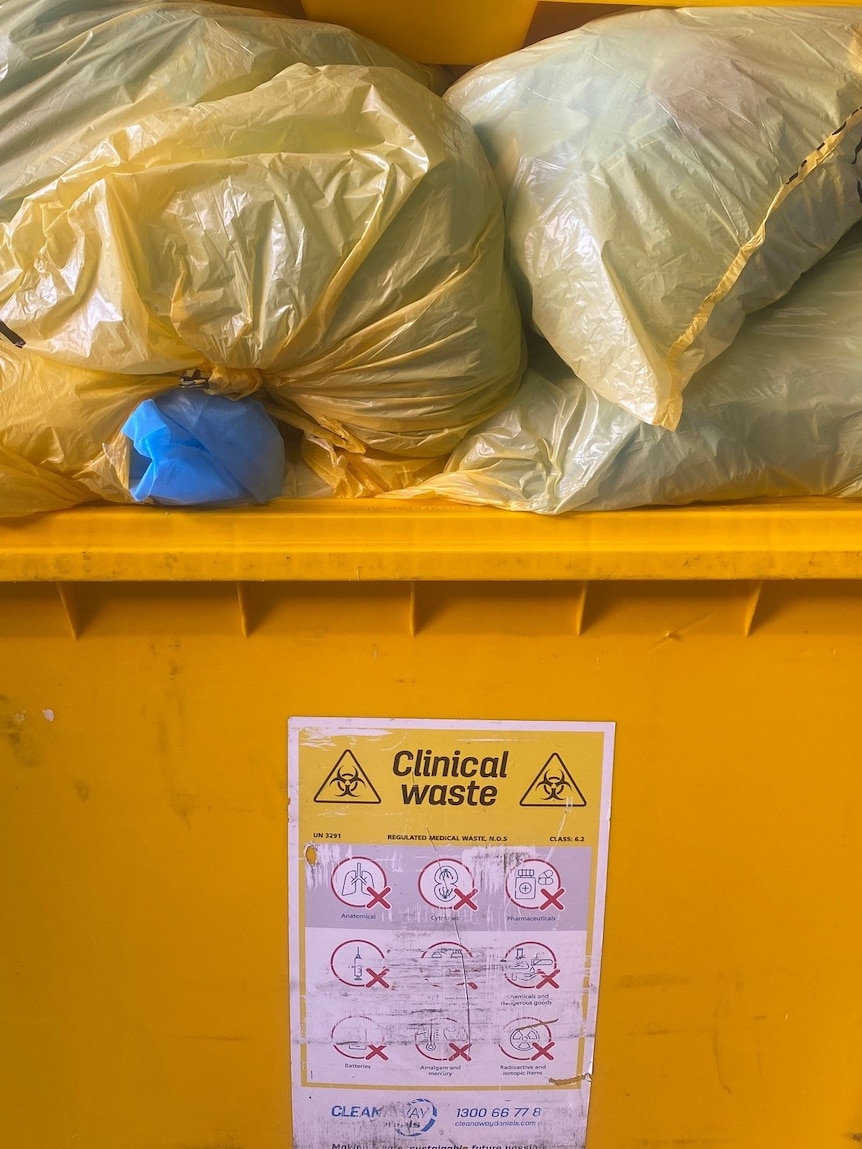A visit to the hospital can be life-saving, but it also reveals huge amounts of waste generated by single-use items such as plastic gloves, needles, plastic packaging, medications and medical equipment.
“Out the other side of one operation you will see eight, nine, 15 bags, full bags of medical waste, of plastic waste, of rubbish being disposed of,” said Professor Nick Watts from the Centre for Sustainable Medicine with the National University of Singapore.
What’s worse are the carbon emissions.
The healthcare sector makes up approximately 7 per cent of Australia’s carbon footprint — twice as much as the aviation sector.
“We find that 12 to 13 per cent of that comes from the hospitals themselves, from the buildings and the energy,” said Professor Watts, who was also the chief sustainability officer for the UK’s National Health Service (NHS).
“But we also find that 20 per cent comes from pharmaceutical sales … and about another 20 per cent from medical devices from an MRI machine or from a scalpel.”
For example, one bottle of the anaesthetic gas desflurane is about the same as burning 440 kilograms of coal. Asthma puffers are also a big contributor to carbon emissions.
But healthcare workers like Professor Watts are on a mission to change this, given carbon emissions and waste are some of the biggest threats to human health.
He’s one of the key speakers at World Health Summit Regional Meeting in Melbourne this week.
“Climate change threatens to undermine the core foundations of good health,” Professor Watts said.
He said hospitals and clinics were starting to change how they were doing things, by “reducing the emissions of health care” while also providing “high-quality services for our patients in the face of climate change”.
The added bonus, Professor Watts pointed out, was that “it actually saves quite a bit of money and improves the care for our patients”.
How are healthcare systems changing for the better?
In his role in the UK, Professor Watts helped the NHS transition to a net-zero health system.
He said there were three pillars in that process — reduce, reuse and recycle.
That includes improving clinicians’ diagnostic skills and reducing the amount of tests patients need, which helps cut waste and carbon.
Then there’s reducing transportation of patients and medicines.
“If we had a slightly more digitally enabled healthcare system, then we could do more with far less waste and in a far less intensive way, like provide care closer to home,” Professor Watts said.
Then there’s reusing medical devices.
“Increasingly we are seeing medical device companies start to turn around and say, ‘Hey, you know what, if you hand this back to us, we think we can re-sterilise it, we can reprocess it, we can get it back to you in a couple of days at a fraction of the cost’; that’s going to save a lot of carbon as well,” he said.
There are also asthma inhaler recycling systems now in the UK to help reduce waste and carbon.
Emergency departments in the NHS are also moving toward net-zero emissions and waste under the Green ED program, which Professor Watts said could be applied globally.
“It provides step-by-step guidance for emergency departments.
“And then a certification system — bronze, gold, silver for individual hospitals, individual clinicians to start to think of all of the different things you could do within an emergency department.”
What’s happening in Australia?
These sorts of practices are now being implemented in Australia, particularly in emergency departments.
Brian O’Connell, an emergency doctor in Coffs Harbour and the sustainable healthcare lead for NSW Health on the mid north coast, said there were hundreds of champions of what’s called sustainable ED in just his health district alone.
“It’s really snowballing,” he said.
“We’re starting to measure our waste streams or carbon footprint more accurately, so we know where these target hotspots are and how we can maximise impact and track progress.”
For example, one health district has cut plastic glove usage by 30 per cent and some emergency departments are aiming to reduce unnecessary testing by a third.
Some surgery departments are also starting to minimise the use of certain anaesthetic gases and find alternatives.
But Brian O’Connell said cutting carbon and waste did not mean reducing the quality of health care.
“What we’re doing is looking at the evidence and how we can do our practices better,” Dr O’Connell said.
He said emergency departments were reducing the use of cannulas and patients actually “tend to do better; they have less pain and they feel more comfortable”.
“There are other ways we can do it.”
Dr O’Connell said the movement had been sweeping across health care in Australia since COVID, when medical waste was at its worst.
“We’re now regrouping and we’re able to stop and think more and take a new approach,” he said.
“It’s low carbon, it’s low waste, and it turns out to be really high-quality health care as well.”




